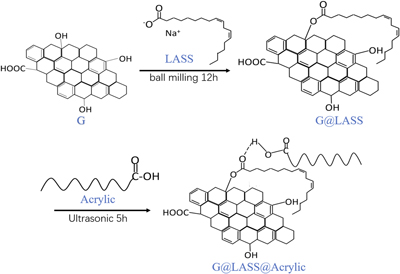Published online by Cambridge University Press: 21 January 2019

Graphene (G) has attracted great interest because of its excellent chemical and electrical properties. However, the aggregation of graphene restricts its application. Herein, linoleic acid sodium salt (LASS), a low-cost and environmentally friendly material, was used to improve the dispersion of graphene through covalent interaction. Then, the mixture (G@LASS) was integrated with acrylic resin matrix via hydrogen bond between the carboxyl and ester groups. The excellent interfacial compatibility between G@LASS and acrylic matrix, as well as good dispersibility of G@LASS, was demonstrated by Fourier-transform infrared spectroscopy, X-ray photoelectron spectroscopy, Raman, and scanning electron microscopy tests. Compared with acrylic matrix, the surface hydrophobicity of G@LASS@Acrylic increased considerably because of its compact structure. G@LASS@Acrylic composites meet the requirement of antistatic materials when the content of G was only about 0.5 wt%. The results showed that conductive pathways were established successfully through this method.